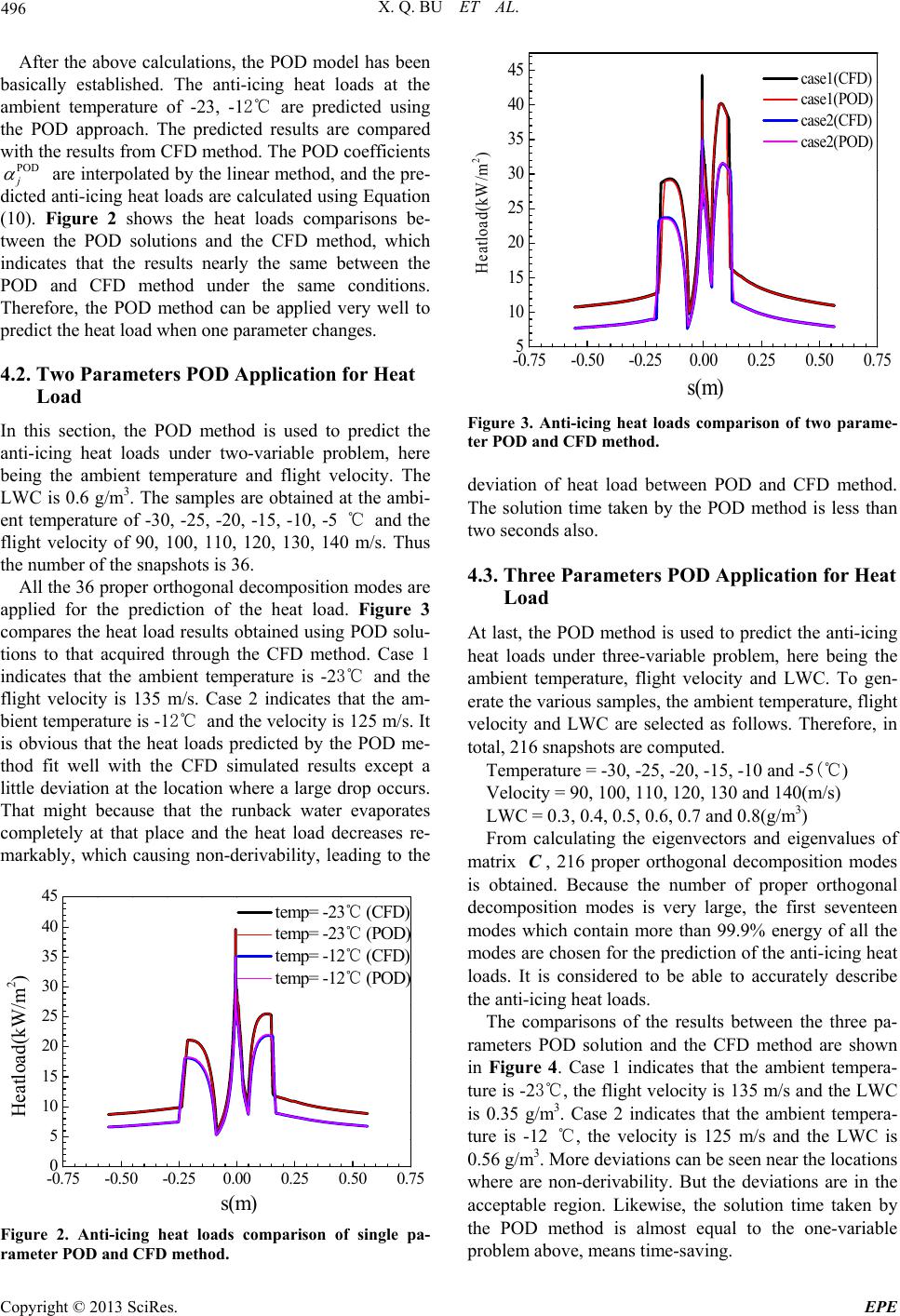
X. Q. BU ET AL.
496
After the above calculations, the POD model has been
basically established. The anti-icing heat loads at the
ambient temperature of -23, -12℃ are predicted using
the POD approach. The predicted results are compared
with the results from CFD method. The POD coefficients
are interpolated by the linear method, and the pre-
dicted anti-icing heat loads are calculated using Equation
(10). Figure 2 shows the heat loads comparisons be-
tween the POD solutions and the CFD method, which
indicates that the results nearly the same between the
POD and CFD method under the same conditions.
Therefore, the POD method can be applied very well to
predict the heat load when one parameter changes.
POD
j
4.2. Two Parameters POD Application for Heat
Load
In this section, the POD method is used to predict the
anti-icing heat loads under two-variable problem, here
being the ambient temperature and flight velocity. The
LWC is 0.6 g/m3. The samples are obtained at the ambi-
ent temperature of -30, -25, -20, -15, -10, -5 ℃ and the
flight velocity of 90, 100, 110, 120, 130, 140 m/s. Thus
the number of the snapshots is 36.
All the 36 proper orthogonal decomposition modes are
applied for the prediction of the heat load. Figure 3
compares the heat load results obtained using POD solu-
tions to that acquired through the CFD method. Case 1
indicates that the ambient temperature is -23℃ and the
flight velocity is 135 m/s. Case 2 indicates that the am-
bient temperature is -12℃ and the velocity is 125 m/s. It
is obvious that the heat loads predicted by the POD me-
thod fit well with the CFD simulated results except a
little deviation at the location where a large drop occurs.
That might because that the runback water evaporates
completely at that place and the heat load decreases re-
markably, which causing non-derivability, leading to the
-0.75 -0.50 -0.250.000.250.500.75
0
5
10
15
20
25
30
35
40
45
s
m
Heatload(kW/m
2
)
temp= -23 (CFD)
℃
temp= -23 (POD)
℃
temp= -12 (CFD)
℃
temp= -12 (POD)
℃
Figure 2. Anti-icing heat loads comparison of single pa-
rameter POD and CFD method.
-0.75-0.50-0.250.00 0.25 0.50 0.75
5
10
15
20
25
30
35
40
45
s(m)
Heatload(kW/m
2
)
case1(CFD)
case1(POD)
case2(CFD)
case2(POD)
Figure 3. Anti-icing heat loads comparison of two parame-
ter POD and CFD method.
deviation of heat load between POD and CFD method.
The solution time taken by the POD method is less than
two seconds also.
4.3. Three Parameters POD Application for Heat
Load
At last, the POD method is used to predict the anti-icing
heat loads under three-variable problem, here being the
ambient temperature, flight velocity and LWC. To gen-
erate the various samples, the ambient temperature, flight
velocity and LWC are selected as follows. Therefore, in
total, 216 snapshots are computed.
Temperature = -30, -25, -20, -15, -10 and -5(℃ )
Velocity = 90, 100, 110, 120, 130 and 140(m/s)
LWC = 0.3, 0.4, 0.5, 0.6, 0.7 and 0.8(g/m3)
From calculating the eigenvectors and eigenvalues of
matrix , 216 proper orthogonal decomposition modes
is obtained. Because the number of proper orthogonal
decomposition modes is very large, the first seventeen
modes which contain more than 99.9% energy of all the
modes are chosen for the prediction of the anti-icing heat
loads. It is considered to be able to accurately describe
the anti-icing heat loads.
C
The comparisons of the results between the three pa-
rameters POD solution and the CFD method are shown
in Figure 4. Case 1 indicates that the ambient tempera-
ture is -23℃, the flight velocity is 135 m/s and the LWC
is 0.35 g/m3. Case 2 indicates that the ambient tempera-
ture is -12 ℃, the velocity is 125 m/s and the LWC is
0.56 g/m3. More deviations can be seen near the locations
where are non-derivability. But the deviations are in the
acceptable region. Likewise, the solution time taken by
the POD method is almost equal to the one-variable
problem above, means time-saving.
Copyright © 2013 SciRes. EPE